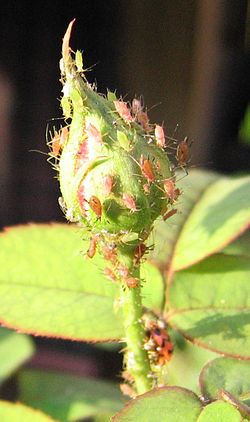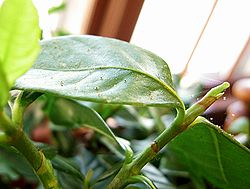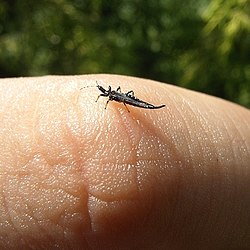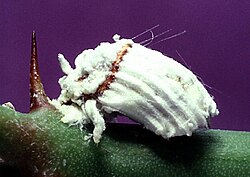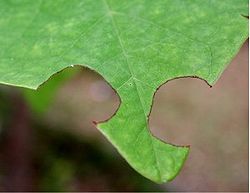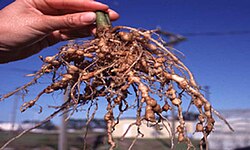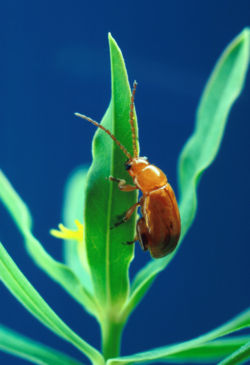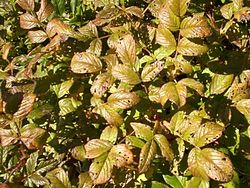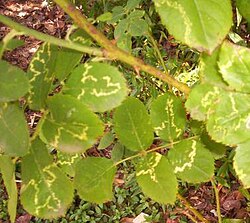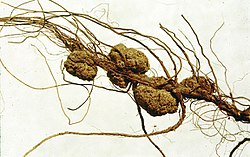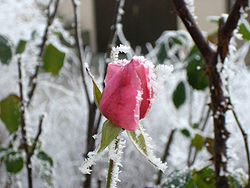AY Honors/Flower Culture/Answer Key
From Pathfinder Wiki
< AY Honors | Flower CultureAY Honors/Flower Culture/Answer Key /
Revision as of 01:43, 7 November 2007 by Jomegat (talk | contribs) (Transwiki:Pests and diseases of roses moved to AY Honor Flower Culture: transwiki move)
Roses Rosa sp. are susceptible to a number of pests, diseases and disorders. A large number of the problems affecting roses are seasonal and climatic.&
Certain varieties of roses are naturally more resistant or immune than others to certain pests and diseases.
Cultivation requirements of individual rose species and cultivars, when observed, often assist in the prevention of certain pests, diseases and disorders.&
Pests
Pests are often considered to be the insects that affect roses:
- Aphids (Greenfly) (Order Hemiptera: Family Aphididae) Macrosiphum rosae
- Likely to be found on new shoots and buds, aphids are soft bodied insects 1-2mm long. Often green but occasionally light-brown, and sometimes with wings, they may cover (in a colony) the complete growing tip of the plant. Aphids are most active in spring and summer and multiply at a prodigeous rate feeding on the sap of the plant by piercing the plant cells via a proboscis. In large quantities they may seriously retard the growth of the plant and ruin buds. They are particularly damaging to the new shoots with subsequent damage to the emerging leaves which become malformed with much the same appearance as leaf-curl in peaches.&
- Two-spotted mite (Spider-mites or Red spider mite) (Order Acari: Family Tetranychidae) Tetranychus urticae
- Previously known as red-spider mite these arachnids prefer the underside of leaves and are difficult to see with an unaided eye. Evidence of their presence is silvering of leaves where the mites have destroyed individual leaf cells. Fine webbing and eggs on the undersides of leaves is further evidence of the presence of Tetranychus urticae.
- Thrips (Order Thysanoptera)
- Thrips are slim-winged insects 1mm in length, resembling fine black slivers of wood. Preferring light-coloured blooms and often appearing in plague numbers flowers are often left looking bruised and lustreless. &
- Caterpillars (Order Lepidoptera) See also List of Lepidoptera which feed on Roses
- The tortryx (tortrix) moth Lozotaenia forsterana is a prominent pest of roses, although not the sole pest. The caterpillars are green, up to 15mm long, and can be found boring into buds or within curled leaves. When disturbed the caterpillars move swiftly, dropping to the ground on a fine thread. Damage is chewn leaves and flowers and buds with "shot holes".
- Curculio beetles (Family Curculionidae)
- Scale insects (Order Hemiptera)
- Cottony cushion scale (Order Hemiptera : Family Coccoidea) Icerya purchasi
- This scale infests twigs and branches. The mature female is oval in shape, reddish-brown with black hairs, 5 mm long. When mature the insect remains stationary and produces an egg sac in grooves, by extrusion, in the body which encases hundreds of red eggs. The insect causes little damage but produces copious honeydew (frass) that can cause damaging sooty mould.
- California red scale (Order Hemiptera : Family Coccoidea) Aonidiella aurantii
- A hard scale, orange to orange-pink, the female covering being less than 1.5mm across. Often in plague numbers this scale infests upper surfaces of foliage causing yellowing, leaf fall, and twig and branch dieback. Serious infestations can cause plant death.
- Rose scale (Order Hemiptera : Family Coccoidea) Aulacaspis rosae
- Mainly found on the stems and branches of the plant, lack of control will allow the pest to spread to flower stalks and petioles. At this point the plant would be stunted, spindly and with a white, flaky crust of scales on the bark. Female Aulacaspis rosaemay live for 1 year and may lay 80 eggs each with several overlapping generations living within milliimetres of the original parent.&
- Leaf cutting bee (Order Hymenoptera : Family Megachilidae) Megachile spp.
- Leafcutter bees are 6-16mm long and mostly black with bands of light-coloured hair. They chew pieces from the edges of leaves. The pieces are regular in shape, circular or oval. Damage is not often significant.
- Nematodes (Eelworms)(Order Tylenchida: Family Heteroderidae)
- Root-knot nematode Meloidogyne spp.
- See - Root-knot nematode - symptoms of Meloidogyne infestation in roses is stunting, slow-growth, pale green leaves and wilting in mild weather.&
- Metallic flea-beetles (Order Coleoptera: Family Chrysomelidae) Altica spp.
Diseases
Fungal, bacterial and viral diseases affect roses:
Fungal diseases
- Black Spot (Class Leotiomycetes: Family Helotiales) Marssonina rosae syn. Diplocarpon rosae
- Marssonina rosae causes black spots on leaves.& The spots, which may be as much as 12mm across, are generally circular and have an irregular edge often with a yellow halo. Leaves frequently turn yellow and fall early. Sometimes new leaves are produced, and these may also become affected.
- Continual defoliation will cause weakness, die-back or death of the plant. Some very susceptible species may have stems affected with a considerable reduction in plant vigour.
- Powdery Mildew Oidium sp.
- Oidium produces a very fine, powdery coating on the surface of buds and leaves. Significant cases have stems and particularly thorns, infected. Attacks on young leaves and buds will cause deformity with retardation of growth. Infected buds will fail to open. The disease is likely in hot, humid weather, with fungal spores overwintering on the stems and fallen leaves.
- Downy mildew (Class Oomycetes : Family Peronosporaceae) Peronospora sparsa
- Peronospora causes purple-red to dark-brown spots on the leaves with irregular margins, however, often angular. Stems, petioles and flower stalks can split and spotted with purple marks. Buds, sepals, petals and calyces can be affected and will present purple spots. New growth affected will be deformed. The disease is spread by wind.
- Rust Phragmidium mucronatum
- Rose rust appears as yellow patches on the surface of leaves, with orange pustules of spores underneath the leaf. The fungus is spread by wind. Affected leaves fall prior to healthy ones and plants may be defoliated in serious infections.
- Anthracnose Sphaceloma rosarum
- Spots caused by this fungus originate from a point where leaves are watersoaked, ususally unnoticeable at first, until they turn black with a very distinct defined edge. As the spots enlarge the centre becomes gray and may fall out resulting in a shot-hole appearance. Defoliation may occur but is often not serious. &
- Grey mould (Class Leotiomycetes: Family Sclerotiniceae) Botrytis cineria
- On roses grey mould is prmiarily a disease of the flowers and buds, leaves are infrequently attacked. Infected buds rot on the stem and infection may progress down the stem. On petals botrytis cineria produces pink rings.
- Verticillium wilt (Class Incertae sedis: Family Verticillium) Verticillium dahliae
- Sooty moulds Alternaria spp.
- Sooty mould appears as black, dry powder on leaves similar to chimney soot. Many sooty moulds grow on the honeydew (frass) produced by sap-sucking insect such as aphids and soft scales. Alternaria does no direct damage to plants but surface cover of leaves will reduce the plants capacity to photosynthesise and may create an unsatisfactory plant appearance. &
- Canker Leptosphaeria coniothyrium and Cryptosporella umbrina
- Cankers present as small yellowish or reddish spots on bark slowly increasing in size. Leptosphaeria coniothyrium turns brown, increases in size, and may eventually girdle the stem. The tissue within the infection begins to dry out and shrink, presenting a shrivelled appearance. If the disease infects only part of the stem, growth above the canker will continue. If it girdles the stem, however, growth will cease and the stem will die. &
Viral diseases
- Rose mosaic
- This disease is caused by a complex or viruses and is charaterised by yellow patterns on the leaves. The patterns vary considerably, ranging between all-over fine blotches to patterns of lines in waves. The patterns may appear on a few or many leaves. Plants are infected by this virus at propagation using infected plant material. &
- Rose Wilt
- Rose wilt is a complex of viruses and is referred to as dieback in some areas. The disease can be spread by vectors such as aphids. Symptoms are variable and range from stunted growth to curled young leaves. The soft tissue symptoms are more evident in spring and new leaves will reflex towards their own petioles. The affected leaves are brittle and easily fall from the plant. Fully formed leaves will 'wilt' as if the plant were water stressed.
Bacterial diseases
- Crown gall rot (Class Alpha Proteobacteria: Family Rhizobiaceae) Agrobacterium rhizogenes
- This disease is characterised by large lumps at the base of the plant stem or on roots. Galls may appear higher on stems as the disease progresses. Galls are soft compared to surrounding plant tissues. The pathogenic bacteria enter the plant via a wound. If the disease affects the plant whilst it is young the plant may be affected to the degree where it will not produce blooms. All affected plants wilt readily and grow poorly. &
Environmental disorders
- Frost
- Frost will destroy fresh growth causing stems and leaves to wilt, turn black and fall away from the plant. Timing pruning to promote growth after the threat of frost is a means to avoid frost damage.
- Herbicide Damage
- Overspray or soil leaching of herbicidal sprays can present with several symptoms:
- Prolonged exposure to overspray of glyphosatewill cause yellow leaves and new leaves will be small and elongated.
- Hormone weedsprays (e.g. 24-D & 245-T) may cause grotesque new growth with thin twisted leaves and distorted buds. Plants may die in severe cases.
- Pre-emergent herbicides contacting the plants' rootsystem via the soil will cause yellowing foliage. Effects of soil borne herbicide may take several years to clear.&
References
- ↑ Ross, D.,Rose-growing for Pleasure, Lothian Publishing, Melbourne, 1985, ISBN 0 85091 181 8 pp. 27
- ↑ Botanica's Organic Gardening, Random House Publishing, Sydney, 2002, ISBN 1 74051 426 2
- ↑ Ross, D.,Rose-growing for Pleasure, Lothian Publishing, Melbourne, 1985, ISBN 0 85091 181 8 pp. 28
- ↑ McMaugh, J. What garden pest or diesase is that?, New Holland Publishing, Sydney, 2001
- ↑ McMaugh, J. What garden pest or diesase is that?, New Holland Publishing, Sydney, 2001
- ↑ Botanica's Organic Gardening, Random House Publishing, Sydney, 2002, ISBN 1 74051 426 2
- ↑ McMaugh, J. What garden pest or diesase is that?, New Holland Publishing, Sydney, 2001
- ↑ Ross, D.,Rose-growing for Pleasure, Lothian Publishing, Melbourne, 1985, ISBN 0 85091 181 8 pp. 28
- ↑ Macoboy, S., Macoboys' Roses, Mallon, Melbourne, 1999, ISBN 1875696008
- ↑ http://www.wvu.edu/~agexten/ipm/disease/rosecank.htm
- ↑ McMaugh, J. What garden pest or diesase is that?, New Holland Publishing, Sydney, 2001
- ↑ McMaugh, J. What garden pest or diesase is that?, New Holland Publishing, Sydney, 2001
- ↑ Ross, D.,Rose-growing for Pleasure, Lothian Publishing, Melbourne, 1985, ISBN 0 85091 181 8 pp. 26
- ↑ Ross, D.,Rose-growing for Pleasure, Lothian Publishing, Melbourne, 1985, ISBN 0 85091 181 8 pp. 27
